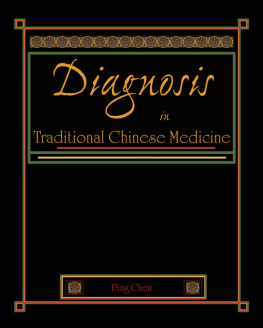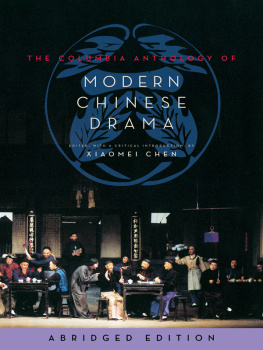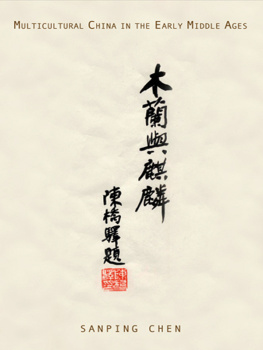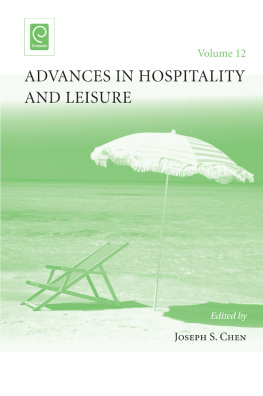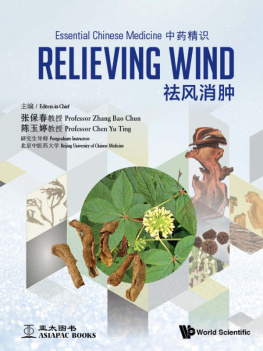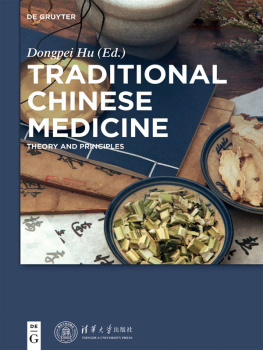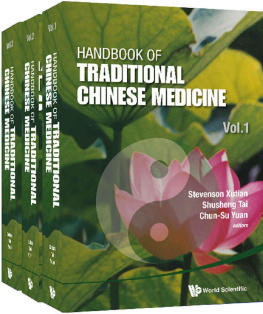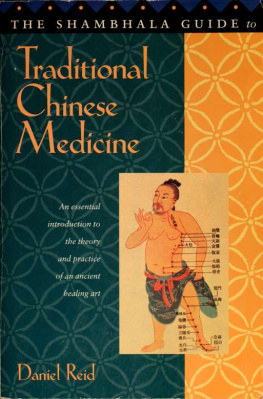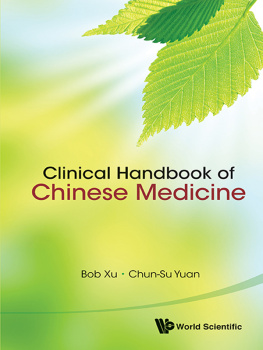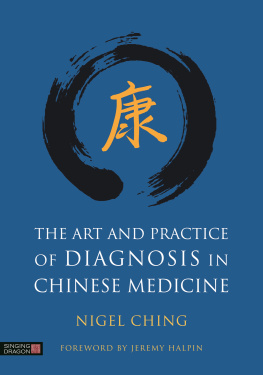Chen - Diagnosis in Traditional Chinese Medicine
Here you can read online Chen - Diagnosis in Traditional Chinese Medicine full text of the book (entire story) in english for free. Download pdf and epub, get meaning, cover and reviews about this ebook. City: Taos;N.M, year: 2004, publisher: Redwing Book Company;Complementary Medicine Press, genre: Home and family. Description of the work, (preface) as well as reviews are available. Best literature library LitArk.com created for fans of good reading and offers a wide selection of genres:
Romance novel
Science fiction
Adventure
Detective
Science
History
Home and family
Prose
Art
Politics
Computer
Non-fiction
Religion
Business
Children
Humor
Choose a favorite category and find really read worthwhile books. Enjoy immersion in the world of imagination, feel the emotions of the characters or learn something new for yourself, make an fascinating discovery.
- Book:Diagnosis in Traditional Chinese Medicine
- Author:
- Publisher:Redwing Book Company;Complementary Medicine Press
- Genre:
- Year:2004
- City:Taos;N.M
- Rating:4 / 5
- Favourites:Add to favourites
- Your mark:
- 80
- 1
- 2
- 3
- 4
- 5
Diagnosis in Traditional Chinese Medicine: summary, description and annotation
We offer to read an annotation, description, summary or preface (depends on what the author of the book "Diagnosis in Traditional Chinese Medicine" wrote himself). If you haven't found the necessary information about the book — write in the comments, we will try to find it.
Chen: author's other books
Who wrote Diagnosis in Traditional Chinese Medicine? Find out the surname, the name of the author of the book and a list of all author's works by series.
Diagnosis in Traditional Chinese Medicine — read online for free the complete book (whole text) full work
Below is the text of the book, divided by pages. System saving the place of the last page read, allows you to conveniently read the book "Diagnosis in Traditional Chinese Medicine" online for free, without having to search again every time where you left off. Put a bookmark, and you can go to the page where you finished reading at any time.
Font size:
Interval:
Bookmark:

Diagnosis in Traditional Chinese Medicine
Ping Chen
ISBN 0-9673034-5-1
Copyright 2004 Ping Chen
Library of Congress Cataloging-in-Publication Data
Chen, Ping, 1953
Diagnosis in traditional Chinese medicine / Ping Chen.
p. ; cm.
Includes bibliographical references and index.
ISBN 0-9673034-5-1 (alk. paper)
1. Diagnosis. 2. Medicine, Chinese.
[DNLM: 1. Diagnosis. 2. Medicine, Chinese Traditional. WB 50.1 C518a 2004a] I. Title.
RC71.C55455 2004
616.075--dc22
2004004360
Published by Complementary Medicine Press
202 Bendix Drive
Taos, New Mexico 87571
Distributed by
Redwing Book Company, Taos NM
www.redwingbooks.com
All rights reserved. No part of this publication may be reproduced, stored in a retrieval system or transmitted in any form by any means, electronic, mechanical, photocopying, recording or otherwise, without the prior written permission of the publisher.

List of Tables and Figures


Council of Oriental Medical Publishers
Designation

This is an original English language work written as a textbook for the authors English-speaking students. A description of the governing terminology and translation method may be found in the glossary.

Foreword

Diagnostics is an important component of traditional Chinese medicine (TCM), serving as the bridge between TCM theory and clinical practice. It includes not only diagnostic techniques, but also the theory and clinical application of pattern identification, which is regarded as the most significant aspect of TCM.
The material for this book comes from many years of teaching TCM diagnostics to both Chinese medical students and university-level Western medical students. I created this book to provide my students with a more complete view of TCM diagnostics practice than has been available in English. I organized my course notes as tables because my English-speaking TCM students found the constant repetition of the main instructional categories (etiology, pathogenesis, and manifestation) confusing when repeated over and over again as narrative prose.
This book consists of two parts. Part One systematically introduces the four diagnostic methods that are unique to TCM, with special emphasis on tongue inspection and pulse examination, the most important diagnostic methods. Part Two discusses the theory and clinical application of the different systems of pattern identification.
The text is arranged into thirteen chapters. Chapter I introduces the main points in the development of TCM diagnostics. Chapters II-V examine the four diagnostic methods: inspection, auscultation and olfaction, interrogation, and palpation and pulse examination. The chapter on interrogation includes symptom patterns, given in the form of tables that list the characteristics of each symptom or sign, along with its pathogenesis and clinical pattern. Reading these chapters will provide a clearer understanding of the methods leading to clinically accurate pattern identification. Chapters VI-XII explain the seven types of pattern identification. They are:
- Pattern identification according to the eight principles
- Pattern identification according to pathogenic factors
- Pattern identification according to qi and blood
- Pattern identification according to the internal organs
- Pattern identification according to the six channels
- Pattern identification according to wei, qi, ying, and blood
- Pattern identification according to upper, middle, and lower burner.
Of these seven, pattern identification in light of organ theory is considered the most important. Included in the explanation for each type of pattern identification are the various manifestations with which a pattern may present; the main manifestations by which a pattern may be identified; an analysis of the etiology and pathogenesis for each symptom or sign of a pattern; and differential diagnosisfor example, those manifestations which help to differentiate one pattern from another. Each pattern is introduced in the order of the main manifestations, common pathogenesis, and systematic pathogenesis. In order to clearly demonstrate the complete philosophic thinking in pattern identification, each pattern is shown in the form of tables. A series of case histories is included in Chapter Thirteen. By comparing these histories with the diagnostic methods of pattern identification introduced in the text, those readers whose goal is to put into practice their knowledge of TCM pattern identification can follow the progression of the philosophic thinking.
Ping Chen, DOM, OMD, MD (PRC)
New Mexico, U.S.A.
CHAPTER ONE

General Introduction

I. IMPORTANT MILESTONES IN THE DEVELOPMENT OF TCM DIAGNOSTICS
During different historical periods in the development of traditional Chinese medicine, many well-known physicians made great contributions to diagnostics. Their names, the era during which they lived, leading works, and their significance in the development of TCM diagnostics are shown in .
II. CLARIFICATION OF SOME TCM TERMS
1. DISEASE
In TCM theory, a disease is a specific process of life. It refers to the result of the interaction of pathogenic factors (known as evil qi) and body resistance (known as vital qi) finally causing the breakdown of the balance between yin and yang.
The action of pathogenic factors on the body is a result of both organic and functional impairment. The body may react to these pathogenic factors in two ways. One is to call up vital qi to expel invading pathogens; the other is to call up vital qi to restore the impaired functions. Furthermore, as specific life processes, breakdown/impairment and expelling/restoration are always dynamic. Their progression is determined by the dynamic interaction between pathogenic factors and bodily resistance.
2. MANIFESTATION
A manifestation refers to the external display of an internal pathogenic development. It includes both symptoms and signs. A manifestation serves as the main evidence for pattern identification.
A symptom refers to the subjective abnormal sensations felt by the patient, for example, pain, distension, numbness, and etc.
A sign refers to the objective abnormal display, which, upon examination, indicates a disease, for example, pale face, skin rashes, or rapid pulse.
Next pageFont size:
Interval:
Bookmark:
Similar books «Diagnosis in Traditional Chinese Medicine»
Look at similar books to Diagnosis in Traditional Chinese Medicine. We have selected literature similar in name and meaning in the hope of providing readers with more options to find new, interesting, not yet read works.
Discussion, reviews of the book Diagnosis in Traditional Chinese Medicine and just readers' own opinions. Leave your comments, write what you think about the work, its meaning or the main characters. Specify what exactly you liked and what you didn't like, and why you think so.

